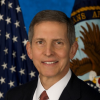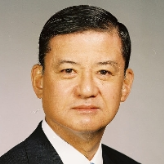- Table of Contents
- Overview
- History
- What it Does
- Where Does the Money Go
- Controversies
- Debate
- Suggested Reforms
- Former Directors
- Comments
- Leave a comment
Independent Agencies

Upon the resignation May 30 of Gen. Eric Shinseki as secretary of the Department of Veterans Affairs, Deputy Secretary Sloan D. Gibson IV, who had been in that post only since March, was called on to lead the organization on an acting basis.
Gibson, 61, was born in Washington, D.C., and attended Hargrave Military Academy, a boarding school in Chatham, Virginia, graduating in 1971. He went on to the United States Military Academy at West Point and graduated from there in 1975 with a degree in national security and public affairs. Service in the armed forces is somewhat of a family tradition: Gibson’s grandfather was an infantry officer during World War I and his father was a tail-gunner on a B-17 during World War II and later was an Air Force officer.
Upon graduation, Gibson was commissioned an officer and served in the infantry, taking Airborne and Ranger training. While serving at Fort Leavenworth in Kansas, Gibson also earned an M.A. in economics from the University of Missouri-Kansas City in 1979.
That degree would serve him well in his post-Army career. He went into banking, working at Bank South in Atlanta and First Union Corp. in North Carolina, before landing at Alabama-based AmSouth Bank in 1992. Gibson started as head of the commercial banking group and eventually became chief financial officer in 1997 and vice chairman. He worked as a troubleshooter, “cleaning up” Nashville-based First American Corp. after its controversial merger with AmSouth in 1999.
In 2002, Gibson served as chairman of the United Way campaign of Central Alabama. He retired from AmSouth in 2004, saying he wanted to spend time in volunteer work. He also earned a master’s degree in public administration from Harvard in 2005.
In September 2008, Gibson was named president and chief executive officer of the United Services Organization (USO). He spent five years at USO, increasing its net fundraising by 90%. He also led the deployment of “USO In a Box,” a trailer with TVs, video games, laptop computers and other amenities that can be helicoptered to a forward base for troops to use during their downtime. Gibson remained at the USO until moving to the VA in March 2014.
Gibson’s career in some ways closely tracks that of another Obama administration official. Secretary of Defense Chuck Hagel served in the Army as a young man, was deputy administrator of the Veterans Administration for a time during the Reagan administration, and later, while working in private industry, was president and CEO of the USO.
Gibson and his wife, Margaret, have two grown daughters, Celia and Laura.
-Steve Straehley
To Learn More:
Witness Testimony of The Honorable Sloan Gibson
V.A.’s Acting Chief: West Point Graduate and Ex-Leader of U.S.O. (by Sheryl Gay Stolberg, New York Times)
57,000 Veterans Waiting more than 3 Months for First Medical Appointments; 64,000 Not Even on the List (by Noel Brinkerhoff, AllGov)

- Latest News
- D.C. Public Schools will Teach all Second-Graders to Ride a Bike
- New Rule in Germany Limits Sales of Sex-Themed E-Books to 10pm to 6am
- What Happened to the 6-Year-Old Tibetan Boy the Chinese Government Kidnapped 20 Years Ago?
- U.S. Ambassador to Turkey Photoshops his Hair Color to Mock Turkish Mayor
- Mystery Artist Calls Attention to Unfixed Potholes by Drawing Penises around Them
Independent Agencies

Upon the resignation May 30 of Gen. Eric Shinseki as secretary of the Department of Veterans Affairs, Deputy Secretary Sloan D. Gibson IV, who had been in that post only since March, was called on to lead the organization on an acting basis.
Gibson, 61, was born in Washington, D.C., and attended Hargrave Military Academy, a boarding school in Chatham, Virginia, graduating in 1971. He went on to the United States Military Academy at West Point and graduated from there in 1975 with a degree in national security and public affairs. Service in the armed forces is somewhat of a family tradition: Gibson’s grandfather was an infantry officer during World War I and his father was a tail-gunner on a B-17 during World War II and later was an Air Force officer.
Upon graduation, Gibson was commissioned an officer and served in the infantry, taking Airborne and Ranger training. While serving at Fort Leavenworth in Kansas, Gibson also earned an M.A. in economics from the University of Missouri-Kansas City in 1979.
That degree would serve him well in his post-Army career. He went into banking, working at Bank South in Atlanta and First Union Corp. in North Carolina, before landing at Alabama-based AmSouth Bank in 1992. Gibson started as head of the commercial banking group and eventually became chief financial officer in 1997 and vice chairman. He worked as a troubleshooter, “cleaning up” Nashville-based First American Corp. after its controversial merger with AmSouth in 1999.
In 2002, Gibson served as chairman of the United Way campaign of Central Alabama. He retired from AmSouth in 2004, saying he wanted to spend time in volunteer work. He also earned a master’s degree in public administration from Harvard in 2005.
In September 2008, Gibson was named president and chief executive officer of the United Services Organization (USO). He spent five years at USO, increasing its net fundraising by 90%. He also led the deployment of “USO In a Box,” a trailer with TVs, video games, laptop computers and other amenities that can be helicoptered to a forward base for troops to use during their downtime. Gibson remained at the USO until moving to the VA in March 2014.
Gibson’s career in some ways closely tracks that of another Obama administration official. Secretary of Defense Chuck Hagel served in the Army as a young man, was deputy administrator of the Veterans Administration for a time during the Reagan administration, and later, while working in private industry, was president and CEO of the USO.
Gibson and his wife, Margaret, have two grown daughters, Celia and Laura.
-Steve Straehley
To Learn More:
Witness Testimony of The Honorable Sloan Gibson
V.A.’s Acting Chief: West Point Graduate and Ex-Leader of U.S.O. (by Sheryl Gay Stolberg, New York Times)
57,000 Veterans Waiting more than 3 Months for First Medical Appointments; 64,000 Not Even on the List (by Noel Brinkerhoff, AllGov)

- Latest News
- D.C. Public Schools will Teach all Second-Graders to Ride a Bike
- New Rule in Germany Limits Sales of Sex-Themed E-Books to 10pm to 6am
- What Happened to the 6-Year-Old Tibetan Boy the Chinese Government Kidnapped 20 Years Ago?
- U.S. Ambassador to Turkey Photoshops his Hair Color to Mock Turkish Mayor
- Mystery Artist Calls Attention to Unfixed Potholes by Drawing Penises around Them






Comments